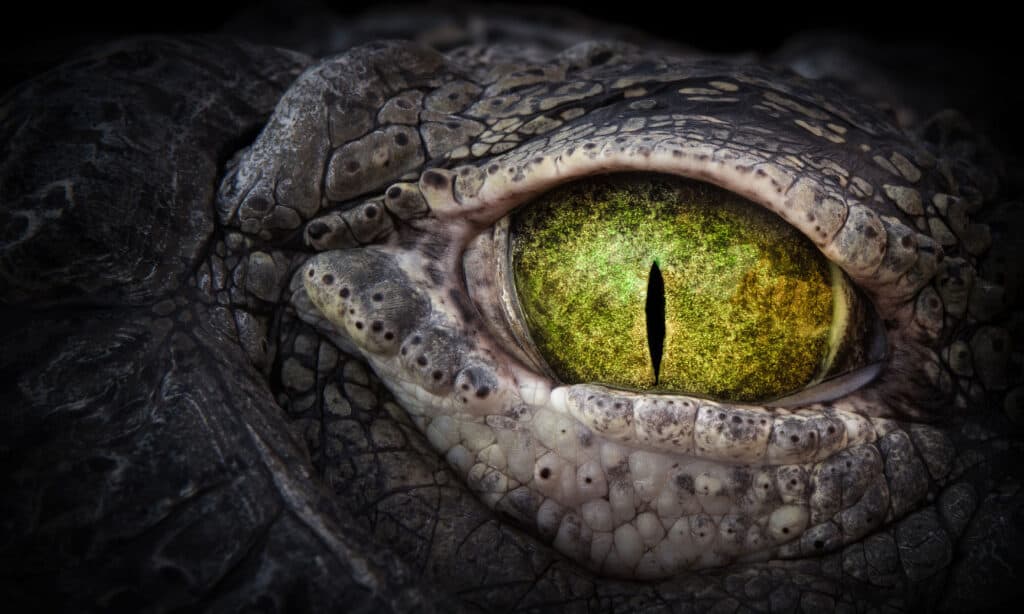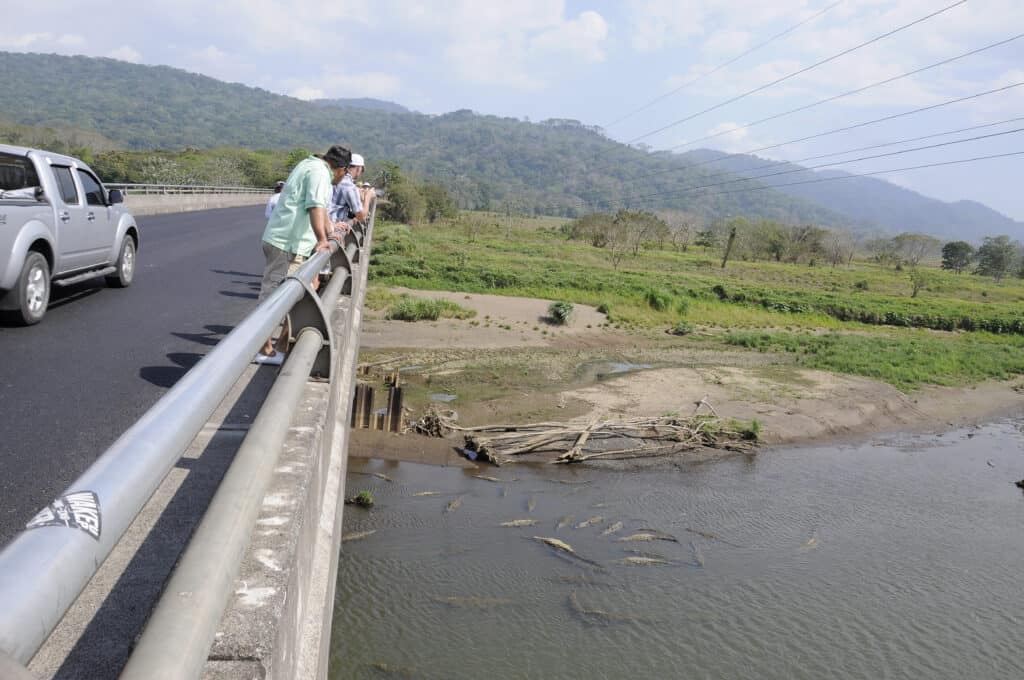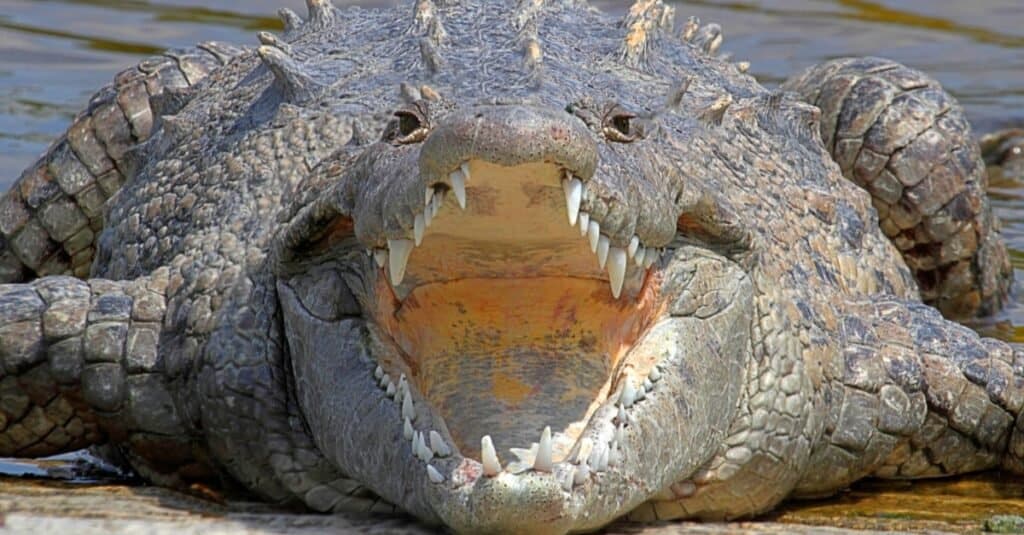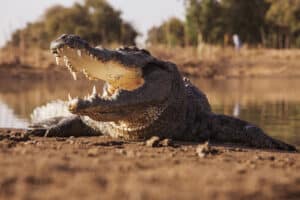Wading through murky water, you never know what could be lurking beneath the surface. A crocodile? An alligator? It’s hard to say without getting too close. But for some people, living near one of the world’s most crocodile-infested rivers is their everyday reality. If you ask around, many people would say that the Tárcoles River in Costa Rica is home to the most crocodiles in the world. This river is undoubtedly a hotspot for crocodiles. So, if you’re ever down in Costa Rica and decide to take a dip in the Tárcoles River, beware… you may just have an encounter with one of these prehistoric creatures.

Where is the most crocodile infested river in the world? The Tárcoles River in Costa Rica is your answer.
©iStock.com/Jeroen Mikkers
All About Tárcoles River
The Tárcoles River is an important waterway in Costa Rica. It runs through the province of Puntarenas, the Central Valley, emptying into the Gulf of Nicoya on the Pacific coast. With a watershed of over 1,242 miles, the average depth of the river is 66 feet and 98 feet wide. Tárcoles River is one of the most contaminated and polluted rivers in Costa Rica. However, despite the contamination, an abundance of wildlife depends on the river for survival due to its key location. Furthermore, the Tárcoles River is an essential source of water for the agricultural and hydroelectric industries in Costa Rica.
All About Crocodile Bridge

The famous “Crocodile Bridge” (or Tárcoles Bridge) and provides a great viewing point to see crocodiles along the Tárcoles river.
©iStock.com/Bob Hilscher
On Carara National Park’s western edge is where you find the famous Crocodile Bridge. Lying close to the town of Tárcoles, it is about an hour north of the capital, San Jose. The bridge spans a section of the Tárcoles River, home to a large number of crocodiles, which you can often see sunning themselves on the banks or swimming in the water. With an average of 75 crocodiles per square mile, the Tárcoles River in Costa Rica is the perfect setting for the world’s highest concentration of crocodiles.
This river is a popular tourist destination because of its crocodiles, believe it or not. Visitors enjoy taking the local boat tours to see the crocodiles up close. Experienced guides lead these tours as they know how to safely navigate the river and avoid any potential danger. Otherwise, visitors are known to snap pictures from the safety of the bridge.
Further, you can add the small museum on the premises to your list of stopovers because it provides information about the crocodiles and their habitat. In addition, vendors sell food and souvenirs in surrounding areas, capitalizing on the crocodile tourism. So, if you want an adventurous and unique experience, be sure to add Crocodile Bridge to your wishlist of the best places to visit in Costa Rica!
All About the Crocodiles

Over 2,000 American crocodiles inhabit the Tárcoles River.
©iStock.com/SteveByland
The crocodiles in the Tárcoles River are mostly the American species (Crocodylus acutus). These crocodiles can grow to 18 feet long and weigh up to 1,000 pounds. The largest recorded specimen of this species measured 20 feet. American crocodiles are generally dark olive-gray on top with a paler underbelly and white patches on the throat and sides of the head. They have long, muscular tails that can propel the animal at speeds of up to 12 mph in short bursts.
An adult American crocodile lives most of its life lounging in freshwater swamps or rivers, and basking on their banks or in brackish waters. This adaptability makes the Tárcoles River an ideal spot as one of the most crocodile infested rivers worldwide. However, the International Union for Conservation of Nature (IUCN) classifies the American crocodile as a threatened species. Still, the population in the Tárcoles River is thriving thanks to the river’s warm water and abundance of food.
Despite their large size and intimidating appearance, American crocodiles are timid creatures that generally avoid humans. So, the crocodiles in the Tárcoles River seem to leave people alone as there have been no reports of attacks on humans in recent years. However, it is still crucial to be cautious when visiting the river and to follow the safety guidelines at all times.
Competing for the Title of “Most Crocodile-Infested River in the World”
The Tárcoles River is home to over 2,000 crocodiles and, as such, is considered the river with the most crocodiles per square mile. But are there any other rivers that can possibly compete with this famous river?

The Nile Crocodile can grow up to 20 feet long and weigh up to 1,650 pounds!
©FARUK BUDAK/Shutterstock.com
There are, in fact, two rivers that could give Tárcoles River a run for her money. The first, and certainly the most well-known, is the Nile River.
There is a population of an estimated 250,000 to 500,000 Nile crocodiles that live on the African continent. As Africa’s longest river, the Nile runs through ten countries and several different physiographic regions. Thousands of crocodiles inhabit the waters of the Nile Basin and along the Nile River Valley in Egypt and Sudan.
Crocodiles have a pretty bad reputation along the Nile River as there have been reports of two different species preying on humans. These species are the freshwater crocodile and, of course, the infamous Nile crocodile.
The second river that competes with the Tárcoles River in terms of crocodile population is the Vishwamitri River in India. Although this river only boasts 300 crocodiles along its banks, the river itself is only 15.5 miles long. This makes the crocodile population in this comparatively small river quite imposing. Additionally, the crocodiles here are said to be some of the most dangerous in the world. Reports of the river’s crocodiles cropping up in the most random places show how they pose a threat to the 1.3 million people in the surrounding area.
Up Next…
- The 9 Most Crocodile-Infested Lakes in the Americas
- Crocodile Death Roll: Everything You Wanted to Know
- Meet the World’s Weirdest Crocodile Species (They’re Orange and Live in Caves!)
- Discover the World’s Oldest Crocodile
The photo featured at the top of this post is © Sergey Uryadnikov/Shutterstock.com
Thank you for reading! Have some feedback for us? Contact the AZ Animals editorial team.






